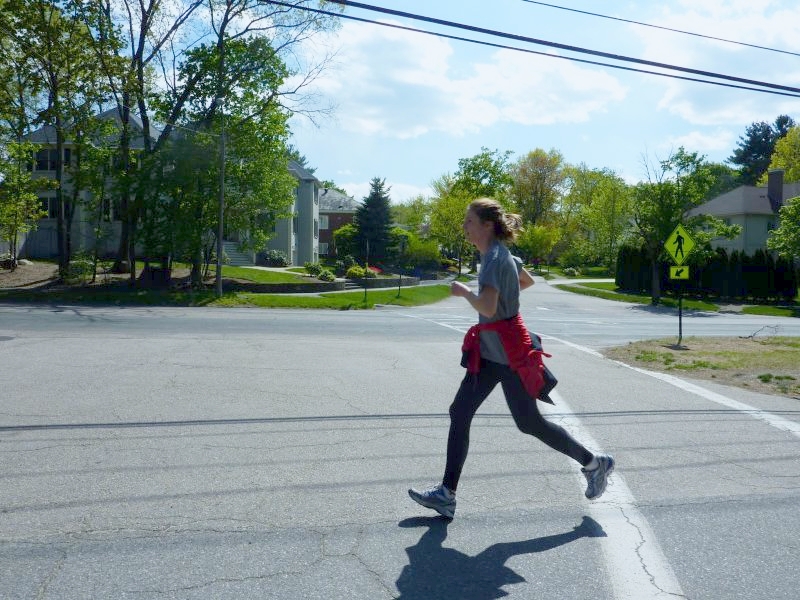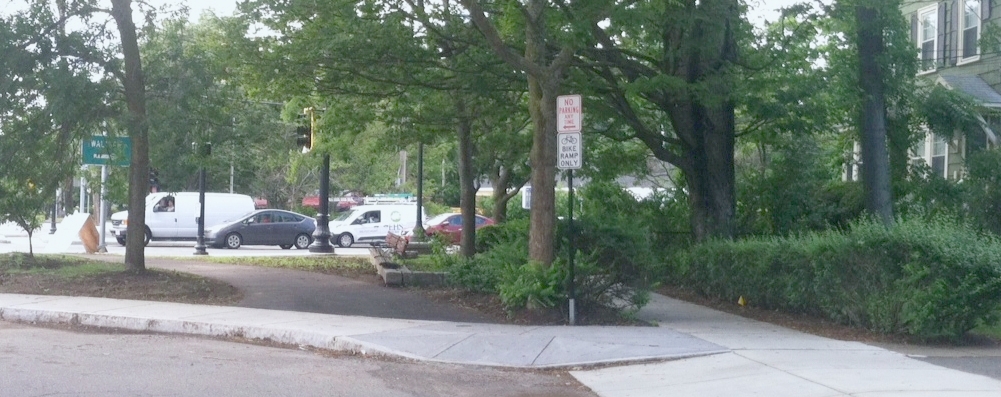Frederick Law Olmsted designed the Newton portion of Commonwealth Ave as part of the Emerald Necklace park system.
It stretches 5.516 miles from Lake Street, at the western border of Brookline, to the Boathouse at the Charles River. The Carriage Lane parallels Commonwealth Avenue almost its entire length, stretching almost the entire east/west length of Newton. The Carriage Road begins in the east at the Green Line’s Boston College MBTA Station, and continues west to Islington Road (just short of the the Boat House, Route 128 and the town of Weston).
One Road, Many Crossroads
North/south travel in Newton without crossing Comm Ave, and thus without crossing the Carriage Road, is virtually impossible. Whether at a signalized intersection such as Washington St., Lowell Ave., Walnut St., Centre St., Grant or Hammond, or the many non-signalized intersections such as Valentine, Prince, or Morseland, every vehicle in Newton traveling either north or south must the Carriage Road at some point.

An increasing number of people rely on the Carriage Lane for bicycle transportation as part of their work commute, for short local trips, and for recreational purposes. Children and families with children in tow utilize the Carriage Lane for family bicycle rides. More and more people are using it year round, not just in the warm months, and the warm months are extending. Increased use by walkers and runners is substantial as well, popularized as the route of the Boston Marathon and the Heartbreak Hill Half Marathon. The City’s own NNHS track teams use it for their training, as do popular fund-raising walks such as Walk for Hunger. With the Covid-19 restrictions, more people than ever began walking along the Carriage Road, and keeping distance from each other as well, thus using the full offering of the berm, road, and sidewalk.
Direction of Travel
Until 2022, the Carriage Road vehicular direction of travel was legally one way only: westbound. This included bicycles. However, in reality, recreational users run, bike and walk both eastbound and westbound. These users of the Carriage Lane range from children pushed in baby carriages or pulled in trailers, to seniors out for their health or to reach a destination. Traffic signaling and road design had to adjust to consider this reality.

Many Safety Issues
Despite heavy use by bicycles and pedestrians traveling westbound and eastbound, the City of Newton did not systematically maintain the Carriage Road as a safe avenue for transportation, or provide funding necessary for that end. Problems and safety hazards abounded. The Carriage Lane was on the Bicycling Network Plan, but no budget or personnel resources had been allocated to addressing safety along the Carriage Lane.
Turning Point: 2008
Our interest in Carriage Road safety began in 2008, soon after we became new homeowners to a home right off the Carriage Lane. We noticed that when we would drive from our home toward the intersection with the Carriage Lane, which was (and is) a one-way road, I would logically turn my head to the left, to where motor vehicles would be traveling from. Then suddenly people, runners, would be at the intersection. Where were they coming from? It seemed from the right, from the west. Drivers would have no warning, no idea we need to be looking right, and toward the west, before we proceed. Were runners allowed to run on this road? Were they allowed to run toward Boston, against the flow of traffic?
Many drivers shared with us that they’d had this same experience, and many bicyclists experienced drivers of the crossroads running stop signs.
Phil is a runner, we both bike, so we know the Carriage Lane from both perspectives. We have also been dog-walking along the Carriage Road, along with thousands of other cyclists, runners, and dog walkers 7 days a week, and people who run with their dogs, 12 months a year.
We bought our safety concerns to a neighborhood meeting about safety, run by police representatives. The police officer who ran the meeting was unconcerned. We felt the city should install signage at the intersection indicating that drivers should look right after stopping, and before going again. Over the years I learned that many others expressed the same concern and shared stories of near misses with runners and others.
2010: Mayor Setti Warren
With the election and 2010 swearing in of Setti Warren as Mayor of Newton, we saw fresh opportunities to have these issues addressed and to have a voice in local matters. Mayor Warren, a cyclist himself, early in his administration convened the Transportation Advisory Committee (TAC), of which my husband was a member, and TAC soon published its recommendations.
First Steps: The Bicycle Advisory Committee
Around that time, Phil and I were putting together our booklet of the Commonwealth Ave Carriage Lane, in which we described safety problems, photographs included, and our safety recommendations. The booklet in hand, I approached Mayor Warren, who directed me to the Bicycle Advisory Committee, a committee initiated as part of the TAC recommendations. There, Lois Levin, then-chairperson of the BAC and co-founder of Bike Newton, was very interested. She brought to my attention that the Carriage Lane safety had been the focus of others before us, notably Professor Peter Furth of Northeastern, whose students studied the area focusing on safe bicycle travel, pointed out many of the deficiencies, and made suggestions.
Carriage Road Promenade I learned that then Alderman Steven Linsky and others had long advocated for improvements and enhancements along this path as well, and had dreams of even calling this the “Carriage Road Promenade!”

2013 Bill Paille, then Director of Transportation, who regularly attended BAC meetings and was supportive of our Carriage Lane concerns and suggestions, ran a packed three-hour public workshop in the City Hall Executive Room on October 29th to review the entire corridor with respect to traffic/bicycle flow, signage, pavement markings, etc. He planted the seed for the City to develop working drawings of the entire corridor and to show some of the improvements documented in the past. Participants included Prof. Peter Furth. There was a general agreement about the way forward, but change in personnel lost any historical record of this momentum we had going forward.
2014
In 2014, Lois and others brought the League of American Bicyclists in to Newton to assess our bike safety. We were given a scorecard and told definitively that the Carriage Road, with its cobbles, would prevent Newton from ever achieving a higher rating.
2016 Auburndale Square Reconstruction
In late 2016 the reconstruction of Auburndale Square acknowledged the need to provide safety for bicyclists across main streets when the engineers took suggestions from the BAC resident members such as John Pelletier. The engineers added bike lanes both east and west of Lexington St., and through the corner park. At my suggestion, they added a bike curb for bicyclists to stay on the Carriage Lane and not have to exit, enter Commonwealth Ave, and then reenter the Carriage Lane on the west side of the intersection. This has been a popular success with our teenagers.

Traffic Council In May 2018, the last four intersections along the Carriage Road that lacked stop signs for safety purposes (Valentine, Wauwinnet, Wimbledon Circle, Higgins) were approved by Traffic Council.
In August 2018, a group of us, including Lou Taverna, Ms. Freedman, Mr. Sobel, Councilor Andreae Downs, and myself met at the intersection of Commonwealth Avenue, the Carriage Road, and Washington Street to discuss a proposal of mine to stripe a bike lane through the Washington St intersection. It was a fruitful meeting, and other ideas for bicycle safety at that location were envisioned by Ms. Freedman that hopefully will now see the light of day.
Bristol Mini-park The City of Newton continued to make numerous large and small improvements. The January 2021 permanent closure of the Carriage Road from Bristol Road to Chestnut Street, discussed in a blog post here, is significant. In November 2022, the Forestry Division planted 14 flowering trees in the berm. We look forward to the formal creation and improvement of “Bristol Mini-park.”



Residents have been pleased at the changes. With even the limited new striping and signage, many feel safer.
Frederick Law Olmstead’s Vision Some of us recall when the Carriage Road was highly used by non-local drivers who wanted to bypass the traffic signals of Commonwealth Avenue, and who drove quickly, endangering all. With this collaboration, we are creating a bicycle-safe, bicycle-friendly, family friendly, runner-friendly and homeowner-friendly Carriage Lane. The Carriage Road is being transformed into a location where, uniquely, local traffic vehicles, bicyclists, runners and other pedestrians coexist, and all can enjoy the beauty that is Newton. We are realizing the original vision of Frederick Law Olmstead, the Founding Father of the Emerald Necklace and the vision for the Commonwealth Avenue Carriage Lane.
To continue, and learn about the “Two-Way” or “Counter Flor” aspect of the improvements, visit our page “Two-Way Bicycling on the Carriage Road.”
To see a slideshow of the transformation of many of the intersections, visit our page, “TRANSFORMATION.”
